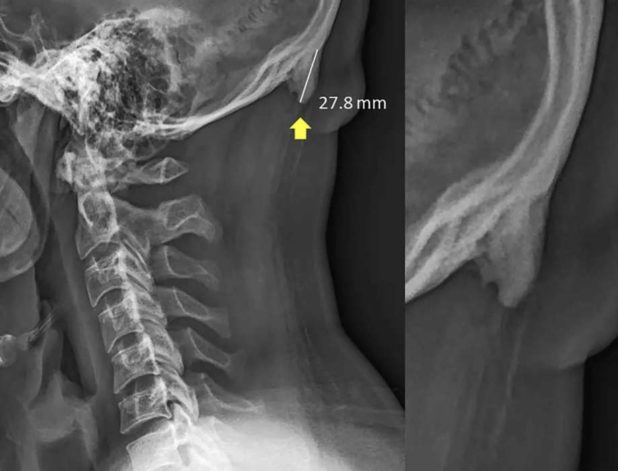Pomidor Quixote
Daily Stormer
June 21, 2019
Average smartphone addict.
If this trend continues, humans a hundred years from now may look nothing like humans today.
Mobile technology has transformed the way we live – how we read, work, communicate, shop and date. But we already know this.
What we have not yet grasped is the way the tiny machines in front of us are remolding our skeletons, possibly altering not just the behaviors we exhibit but the bodies we inhabit.
New research in biomechanics suggests that young people are developing hornlike spikes at the back of their skulls – bone spurs caused by the forward tilt of the head, which shifts weight from the spine to the muscles at the back of the head, causing bone growth in the connecting tendons and ligaments. The weight transfer that causes the buildup can be compared to the way the skin thickens into a callus as a response to pressure or abrasion.
The result is a hook or hornlike feature jutting out from the skull, just above the neck.
In academic papers, a pair of researchers at the University of the Sunshine Coast in Queensland, Australia, argues that the prevalence of the bone growth in younger adults points to shifting body posture brought about by the use of modern technology. They say smartphones and other handheld devices are contorting the human form, requiring users to bend their heads forward to make sense of what’s happening on the miniature screens.
Women are all addicted to their smartphones and thus they are the most likely to have horns.
The researchers said their discovery marks the first documentation of a physiological or skeletal adaptation to the penetration of advanced technology into everyday life.
Health experts warn of “text neck,” and doctors have begun treating “texting thumb,” which is not a clearly defined condition but bears resemblance to carpal tunnel syndrome. But prior research has not linked phone use to bone-deep changes in the body.
“An important question is what the future holds for the young adult populations in our study, when development of a degenerative process is evident in such an early stage of their lives?” ask the authors in their most recent paper, published in Nature Research’s peer-reviewed, open access Scientific Reports. The study came out last year but has received fresh attention following the publication last week of a BBC story that considers, “How modern life is transforming the human skeleton.”
That’s an excellent question. Keep in mind that these horns are just one physical symptom of the technology overdose affecting young people.
There’s also the fact that their brains are getting deeply rewired from an early age. Their reward centers are all messed up by these smartphone apps and games and social media platforms, which are designed to be addictive by purposely fucking with their dopamine systems.
Toddlers are glued to a screen and forced to watch ads to “earn diamonds.”
Since then, the unusual formations have captured the attention of Australian media, and have variously been dubbed “head horns,” “phone bones,” “spikes” or “weird bumps.”
Each is a fitting description, said David Shahar, the paper’s first author, a chiropractor who recently completed a PhD in biomechanics at Sunshine Coast.
“That is up to anyone’s imagination,” he told The Washington Post. “You may say it looks like a bird’s beak, a horn, a hook.”
However it is designated, Shahar said, the formation is a sign of a serious deformity in posture that can cause chronic headaches and pain in the upper back and neck.
Part of what was striking about their findings, he said, was the size of the bone spurs, which are thought to be large if they measure 3 or 5 millimeters in length. An outgrowth was factored in to their research only if it measured 10 millimeters, or about two-fifths of an inch.
The danger is not the head horn itself, said Mark Sayers, an associate professor of biomechanics at Sunshine Coast who served as Shahar’s supervisor and co-author. Rather, the formation is a “portent of something nasty going on elsewhere, a sign that the head and neck are not in the proper configuration,” he told The Washington Post.
…
“These formations take a long time to develop, so that means that those individuals who suffer from them probably have been stressing that area since early childhood,” Shahar explained.
The sort of strain required for bone to infiltrate the tendon pointed him to handheld devices that bring the head forward and down, requiring the use of muscles at the back of the skull to prevent the head from falling to the chest. “What happens with technology?” he said. “People are more sedentary; they put their head forward, to look at their devices. That requires an adaptive process to spread the load.”
That the bone growth develops over a long period of time suggests that sustained improvement in posture can stop it short and even ward off its associated effects.
…
Shahar is pressing people to become as regimented about posture as they became about dental hygiene in the 1970s, when personal care came to involve brushing and flossing every day. Schools should teach simple posture strategies, he said. Everyone who uses technology during the day should get used to recalibrating their posture at night.
As motivation, he suggested reaching a hand around to the lower rear of the skull. Those who have the hornlike feature likely can feel it.
So… do you have the technology horn or not?
Technology is corrupting the human form. It was supposed to serve us. It was supposed to be a tool but in a weird twist people became addicted to their tools.
It has turned into a tool to enslave us.
Phone apps are designed to be addictive. They are tested to get the perfect balance of color, sound, “notifications,” fake achievements and fake rewards to trigger strategic releases of dopamine.
Imagine what that does to the brain of a young kid.
Daily Mail, May 3, 2014:
Playing games such as Angry Birds on a mobile can make toddlers slower at learning to talk, experts warn.
A study found that children under three who used smartphones and tablets scored lower in verbal tests than those who did not.
However, 60 per cent of the parents of the children in the study believed that playing on touchscreen devices helped with toddlers’ learning and development.
Study author, Dr Ruth Milanaik from the Cohen Children’s Medical Centre of New York, said: ‘It was striking to see that parents were substituting books and general baby toys for smart phones.
‘Many parents did not seem to bring any other distraction for their children except the touch screen devices.’
While 60 per cent of parents in the study said they believed using touch screen devices was beneficial for their children, the results showed that children playing non-educational games such as Angry Birds or Fruit Ninja actually scored lower in verbal tests than children who are not exposed to these games.
This is just the beginning.
We’ll learn of more physical and mental consequences of technology as the years pass and this guinea pig generation grows older.
The modern world is attacking your nature.
 Daily Stormer The Most Censored Publication in History
Daily Stormer The Most Censored Publication in History






